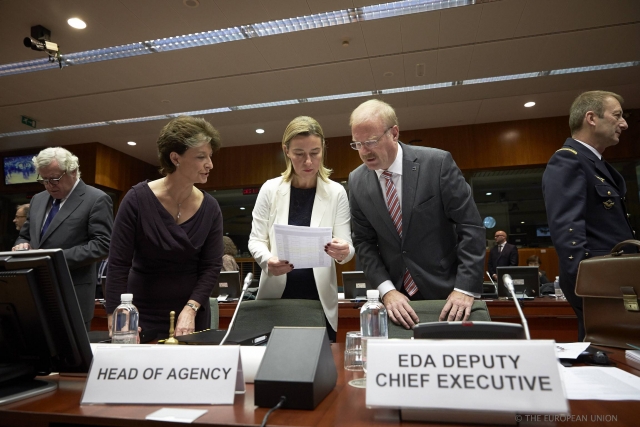Mogherini’s stepping-stone as EU Defence Chief
External Relations 1 December 2014During her hearing before the European Parliament, the new EU High Representative Federica Mogherini stated she would be “ready to fully commit to play a strong role in security and defence matters”, and it was already the case last week, when she chaired her first ever Foreign Affairs Council in the “defence formation”.
The FAC-defence roughly happens four times a year, reuniting the 28 Ministers of Defence with a usually standardized agenda on the three “classic strands”: defence capabilities, military operations and external partnerships. Mogherini (who’s at the same time High Representative for Foreign and Security Policy, Vice-President of the European Commission and, not least, Head of the European Defence Agency) is already twisting the old frame, proposing new working methods (a deeper strategic outlook and topical issues to be tackled in each Council) as well as a stronger media emphasis.
A highly controversial domain, defence cooperation has been downplayed at length, bounded by the consequences of the financial crisis and by an often divergent strategic vision of Member States, while the EU substantially lacked impetus and political will.
Yet, the shared gains of such long-term cooperation slowly became evident as they may bring savings to national economies, optimizing the allocation of existing financial resources and narrowing the “capability-gap” within the EU.
In December 2013, the European Council stated that defence remains one of the main enablers to let EU uphold its external ambitions and global responsibilities, and concluded that cooperation in this domain shall be reinforced. A threefold ambitious roadmap went as result: increasing the effectiveness, visibility and impact of security and defence policy; enhancing the development of security and military means and strengthening Europe’s defence industry.
In this perspective, last FAC-defence was a follow-up to December 2013. Ministers did not propose revolutionary measures, but injected renewed energy in the dossiers, setting a clear operational agenda and rejuvenating projects lost in the loop of the EU institutions. All those strands have been condensed in the “Policy Framework for Systematic and Long-Term Defence Co-operation”, a programmatic roadmap outlining future Member States cooperation, in the same vein of the “Pooling and Sharing” track. Practical implementation will mostly follow through a new array of projects to be managed by the European Defence Agency (such as “pooled procurement” frameworks), under the political guidance of Mogherini and Ministries of Defence. Much work has already been done by the EDA Chief, Ms Claude-France Arnould, who will end her mandate in 2015 leaving a sound legacy (and tough job) to her successor.
Among the new initiatives, there was a strong commitment in the elaboration of new research and development programmes for dual-use goods, i.e. those with both civilian and military application. A first proposal is already being processed in the European Parliament, and will initiate a whole new range of call for proposals from 2017-18.

Claude-France ARNOULD, Chief Executive of the European Defence Agency with Federica MOGHERINI,
High Representative of the EU for Foreign Affairs and Security Policy
Photocredit: Council of the EU.
Besides these more practical issues, the Council meeting deserved much attention for its high political value. Federica Mogherini demonstrated enormous confidence with the subject and clearly showed her good relationship with the new NATO Secretary General, Jens Stoltenberg – only at his third day in office.
The EU boosted its cooperation on the sea as well as in the “fourth domain”, with concrete steps towards the agreement on the Maritime Security Strategy action plan and the adoption of the Cyber Defence Policy Framework.
The “ghost wandering in EU defence” has been spotted too, as Ministers held discussions on the Article 44 of the Treaty – the provision allowing a subgroup of the 28 Member States to perform CSDP (Common Defence and Security Policy) initiatives or operations under the EU flag (and with the EU common budget). Even though it is still too early to show any enthusiasm, the discussion reveals that work is advancing (whether for strong political backing or actual necessity), and may eventually grant the EU an invaluable tool to swiftly respond to emerging crisis without getting lost on the lines of its everlasting internal divisions.
The next European Council dealing with defence matters will be in June 2015. If Mogherini and EU Member States will abide by this foreword, we might witness the first consequences on the ground, with more effective operations delivered by a more capable (and financially efficient) Union. A quite promising outlook for Mogherini’s première.


